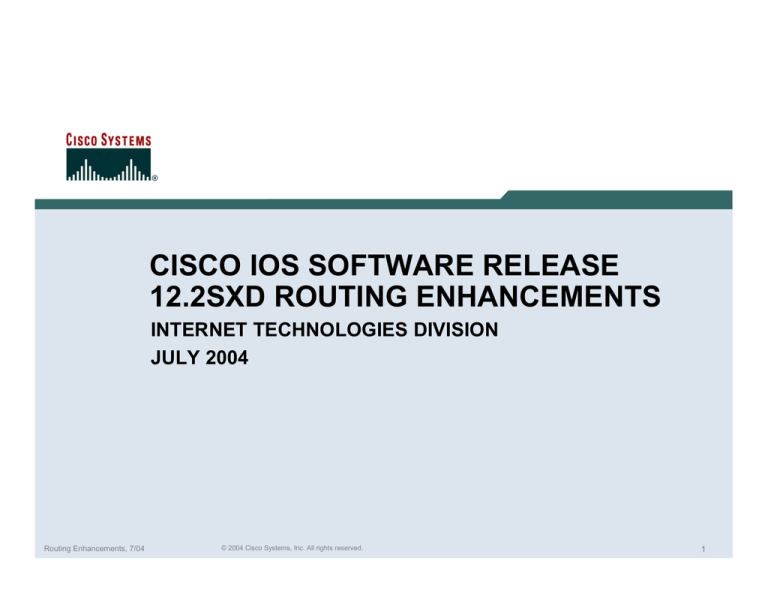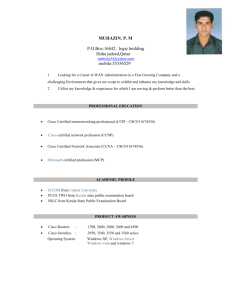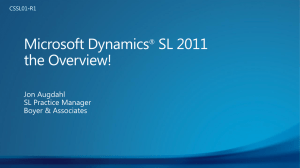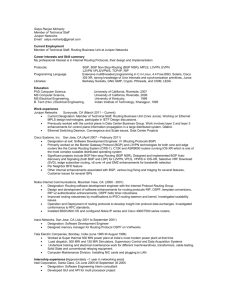
CISCO IOS SOFTWARE RELEASE
12.2SXD ROUTING ENHANCEMENTS
INTERNET TECHNOLOGIES DIVISION
JULY 2004
Routing Enhancements, 7/04
© 2004 Cisco Systems, Inc. All rights reserved.
1
Agenda
• Introduction
• Border Gateway Protocol (BGP) Convergence Optimization
• BGP Dynamic Peer Groups
• Incremental Shortest Path First (iSPF)
• Intermediate System-to-Intermediate System (IS-IS) Exclude
Connect IP Prefix From Label Switched Path (LSP)
• Open Shortest Path First (OSPF) Fast Hellos
• OSPF LSP Throttling
• Conclusion
Routing Enhancements, 7/04
© 2004 Cisco Systems, Inc. All rights reserved.
2
Introduction
• Cisco IOS® Software Release 12.2(18)SXD consolidates
recent routing enhancements previously available in
Releases 12.0S and 12T
• Enhancements are mainly concerned with improving
scalability and convergence time
• Permit a higher degrees of routing protocol
customization, enabling customers to adjust those
parameters applicable for their deployment
Routing Enhancements, 7/04
© 2004 Cisco Systems, Inc. All rights reserved.
3
Agenda
• Introduction
• BGP Convergence Optimization
• BGP Dynamic Peer Groups
• Incremental SPF
• IS-IS Exclude Connect IP Prefix From LSP
• OSPF Fast Hellos
• OSPF LSP Throttling
• Conclusion
Routing Enhancements, 7/04
© 2004 Cisco Systems, Inc. All rights reserved.
4
BGP Convergence Optimization
• Refers to a series of BGP enhancements
• Cisco Routing Scalability Team analyzed the roadblocks
in BGP convergence and addressed them individually
• Combination of code optimizations and deployment /
configuration recommendations
• Results in this section are based on tests with 12.0S
(where functionality was first released)
12.2S benefits from this functionality; results should be
comparable
Routing Enhancements, 7/04
© 2004 Cisco Systems, Inc. All rights reserved.
5
BGP Initial Convergence
• Involves advertising 120,000 routes to hundreds of peers
A vendor’s implementation of BGP plays a major role in how fast
a router can converge initially
• Cisco IOS Software recently introduced a series of
enhancements and fixes
NOTE: all graphs show the percentage improvement in the
number of BGP peers which can be supported while still
converging in less than 10 minutes
Routing Enhancements, 7/04
© 2004 Cisco Systems, Inc. All rights reserved.
6
BGP Initial Convergence – TCP Interaction
• Conservative interaction between BGP and TCP resulted
in slow UPDATE propagation
TCP frames were not being filled properly for maximum
capacity
• Solution: alter BGP/TCP interaction to fill frames
completely
• Simple solution provided a 133% increase in number of
peers supported
Routing Enhancements, 7/04
© 2004 Cisco Systems, Inc. All rights reserved.
7
BGP Initial Convergence – Peer Groups
• Problem: advertise 120,000 routes to hundreds of
peers. BGP will need to send a few hundred megs
of data in order to converge all peers.
• Solution: use peer-groups
UPDATE generation is done once per peer-group
The UPDATEs are then replicated for all peer-group
member
• Scalability and convergence is enhanced because
more peers can be supported
Routing Enhancements, 7/04
© 2004 Cisco Systems, Inc. All rights reserved.
8
BGP Initial Convergence – Peer Groups
• UPDATE generation without peer-groups
The BGP table is walked once, prefixes are filtered through
outbound policies, UPDATEs are generated and sent…per peer!
• UPDATE generation with peer-groups
A peer-group leader is elected for each peer-group. The BGP
table is walked once (for the leader only), prefixes are filtered
through outbound policies, UPDATEs are generated and sent to
the peer-group leader and replicated for peer-group members that
are synchronized with the leader
Replicating an UPDATE is much easier/faster than formatting an
UPDATE, which (unlike replication) requires a table walk and
policy evaluation
Routing Enhancements, 7/04
© 2004 Cisco Systems, Inc. All rights reserved.
9
BGP Initial Convergence – Peer Groups
Synchronization
• A peer-group member is synchronized with the leader if all
UPDATEs sent to the leader have also been sent to the peergroup member
The more peer-group members stay in sync the more UPDATEs
BGP can replicate
• A peer-group member can fall out of sync for several reasons:
Slow TCP throughput
Rush of TCP Acks fill input queues resulting in drops
Peer is busy doing other tasks
Peer has a slower CPU than the peer-group leader
Routing Enhancements, 7/04
© 2004 Cisco Systems, Inc. All rights reserved.
10
BGP Initial Convergence – Peer Groups
• Peer-groups provide a significant increase in scalability
Percentage improvement
Advantage of Peer Groups
250
200
Baseline (zero)
150
TCP Improvements
100
Peer Groups
50
0
Results
Routing Enhancements, 7/04
© 2004 Cisco Systems, Inc. All rights reserved.
11
BGP Initial Convergence – Input Queues
• If a BGP speaker is pushing a full Internet table to a
large number of peers, convergence is degraded due to
enormous numbers of dropped TCP Acks (100k+) on the
interface input queue
Typical ISP gets ~½ million drops in fifteen minutes on an
average route reflector
• Increasing the size of the input queue, thus reducing the
number of dropped TCP Acks, improves BGP
scalability, and reduces convergence
Routing Enhancements, 7/04
© 2004 Cisco Systems, Inc. All rights reserved.
12
BGP Initial Convergence – Input Queues
• Rush of TCP Acks from peers can quickly fill the seventy-five spots
in process level input queues
• Increasing queue depths (4096) improves BGP scalability
hold-queue <1-4096> in
Percentage Improvement
Larger Input Queues
1000
800
Baseline (zero)
600
TCP Improvements
400
Peer Groups
Larger Input Queues
200
0
Results
Routing Enhancements, 7/04
© 2004 Cisco Systems, Inc. All rights reserved.
13
BGP Initial Convergence – MTU Size
• Default MSS (Max Segment Size) is 536 bytes
• Inefficient for today’s POS/Ethernet networks
• Using “ip tcp path-mtu-discovery” improves convergence
ip tcp path-mtu-discovery
Percentage Improvement
MTU Discovery
1000
800
Baseline (zero)
600
TCP Improvements
Peer Groups
400
Larger Input Queues
200
MTU Discovery
0
Results
Routing Enhancements, 7/04
© 2004 Cisco Systems, Inc. All rights reserved.
14
BGP Initial Convergence – MTU Size
Simple config changes can give significant improvement
MTU Discovery + Larger Queues
Baseline (zero)
Percentage
Improvements
1000
800
TCP Improvements
600
Peer Groups
400
Larger Input Queues
200
MTU Discovery
0
Results
Routing Enhancements, 7/04
© 2004 Cisco Systems, Inc. All rights reserved.
MTU Discovery + Larger
Input Queues
15
UPDATE Packing
• A BGP UPDATE contains a group of attributes that characterize
one (or more) prefixes
Ideally, all the prefixes that have the same attributes should be
advertised in the same UPDATE message (use as few messages as
possible)
For example:
BGP tables contain 100,000 routes and 15,000 attribute combinations:
user can advertise all routes with 15,000 updates if prefixes can be
packed 100%
100,000 updates indicate that the user achieves 0% update packing
• Convergence times vary greatly depending on the number of
attribute combinations used in the table and on how well BGP
packs updates
Routing Enhancements, 7/04
© 2004 Cisco Systems, Inc. All rights reserved.
16
BGP Initial Convergence – Update Packing
• Improved update generation algorithm
100% update packing – attribute distribution no longer makes
a significant impact
100% peer-group replication – no longer have to worry about
peers staying “in sync”
Routing Enhancements, 7/04
© 2004 Cisco Systems, Inc. All rights reserved.
17
BGP Initial Convergence – Update Packing
Improvement of almost 2000% for 120K routes
Percentage Improvement
Update Packing
TCP Improvements
2500
2000
Peer Groups
1500
Larger Input Queues
1000
MTU Discovery
500
MTU Discovery + Larger
Input Queues
0
Results
Routing Enhancements, 7/04
Baseline (zero)
© 2004 Cisco Systems, Inc. All rights reserved.
Update Packing
18
BGP Initial Convergence –
Putting It All Together
• Update packing + Peer Groups + MTU discovery + Larger input
queues = > 4500% Improvement
P e rc e n ta g e I m p ro v e m e n t
All Improvements Combined
Baseline (zero)
TCP Improvements
5000
4000
Peer Groups
3000
Larger Input Queues
2000
MTU Discovery
1000
MTU Discovery + Larger Input
Queues
0
Results
Routing Enhancements, 7/04
© 2004 Cisco Systems, Inc. All rights reserved.
Update Packing
19
BGP Initial Convergence – Summary
• Significant improvements gained just by using
configuration options
Use peer-groups
Adjust input queues
Use path MTU discovery
• No need for network upgrades; enhancements are
router specific (internal)
No interoperability issues
Routing Enhancements, 7/04
© 2004 Cisco Systems, Inc. All rights reserved.
20
Agenda
• Introduction
• BGP Convergence Optimization
• BGP Dynamic Peer Groups
• Incremental SPF
• IS-IS Exclude Connect IP Prefix From LSP
• OSPF Fast Hellos
• OSPF LSP Throttling
• Conclusion
Routing Enhancements, 7/04
© 2004 Cisco Systems, Inc. All rights reserved.
21
BGP Peer Groups
• The main benefits of peer-groups are:
UPDATE replication: only one UPDATE message is created per
peer-group – it is then sent to each individual member.
Configuration grouping: all the members of a peer-group MUST
have the same outgoing policy.
• Any deviation from the peer-group’s outgoing policy causes
the peer not to be able to be a part of the peer-group
Results in longer configuration files.
• Peer groups have been shown to significantly improve
convergence
• The configuration must be simplified in order to encourage
wide deployment of peer groups
Routing Enhancements, 7/04
© 2004 Cisco Systems, Inc. All rights reserved.
22
BGP Dynamic Peer Groups
• Peer-group members must have the same outgoing policy
• Dynamic peer-groups eases the configuration by internally
determining which peers have the same outgoing policy and
then generating only one UPDATE for such peers
No configuration needed
• Updates are replicated for each member of the group
Reduced CPU and memory requirements
Faster convergence
Routing Enhancements, 7/04
© 2004 Cisco Systems, Inc. All rights reserved.
23
Agenda
• Introduction
• BGP Convergence Optimization
• BGP Dynamic Peer Groups
• Incremental SPF
• IS-IS Exclude Connect IP Prefix From LSP
• OSPF Fast Hellos
• OSPF LSP Throttling
• Conclusion
Routing Enhancements, 7/04
© 2004 Cisco Systems, Inc. All rights reserved.
24
SPF Computation Review
• Dijkstra algorithm runs by examining each node’s LSPs in
LSDB
Build TENT database and Path database (SPT)
Insert routes into routing tables
• SPF computation is triggered when receiving a new LSA
A new LSA can be received as a result of a link cost change or
adding a stub network
• The computation usually involves all routers in the same
routing area/domain
Routing Enhancements, 7/04
© 2004 Cisco Systems, Inc. All rights reserved.
25
SPF Computation
• Some changes affect only a small part of the SPT, and
some do not affect it at all
• Thus, it maybe unnecessary to run a “full” SPF
computation when there is a topology change, or to run
SPF at all when receiving a new LSA
Routing Enhancements, 7/04
© 2004 Cisco Systems, Inc. All rights reserved.
26
Shortest Path Tree
7
A
Routing
Topology
2
D
B
5
2
1
E
2
C
5
2
4
G
F
1
C
Shortest
Path Tree
from
node C
view
B
Cost b/w A
and D change
from 2 to 5
F
E
C
G
D
A
B
A
F
G
E
D
If there is a stub link, changes of the stub link will not have
impact on the SPT, but SPF will run anyway
Routing Enhancements, 7/04
© 2004 Cisco Systems, Inc. All rights reserved.
27
Incremental SPF – Concept
• Incremental SPF (iSPF) allows routers
to intelligently determine where the
impact of the change is in the SPT and
then only re-computes the effected
nodes to update the SPT
• As a result, it reduces convergence
time by reducing SPF processing time
• Amount of convergence time and CPU
cycles saved depend on how many
nodes that Dijkstra algorithm would
need to examine with and without iSPF
The amount of convergence time saved
tends to increase as the user moves
further from the change
With
iSPF
A
B
C
D
E
X
F
Routing Enhancements, 7/04
© 2004 Cisco Systems, Inc. All rights reserved.
28
Incremental SPF – Configuration and
Deployment
OSPF Configuration
router
router ospf
ospf 11
[no]
[no] incremental-spf
incremental-spf
Ideal for routing area/domain
with large number of nodes
and/or stub links
ISIS Configuration
router
router isis
isis
incremental-spf
incremental-spf [level-1|level[level-1|level2|level-1-2]
2|level-1-2] [<1-100>]
[<1-100>]
Final parameter [<1-100>] is
number of full Dijkstra runs
which will be performed
before incremental runs begin
Routing Enhancements, 7/04
© 2004 Cisco Systems, Inc. All rights reserved.
29
Incremental SPF – OSPF Debug Output
debug ip ospf spf statistic
Without
iSPF
With
iSPF
Routing Enhancements, 7/04
•
OSPF: Begin SPF at 188927.520ms, process time 149760ms
•
OSPF: End SPF at 188927.572ms, Total elapsed time 52ms
•
Intra: 48ms, Inter: 0ms, External: 0ms
•
R: 488, N: 758, Stubs: 598
•
SN: 0, SA: 0, X5: 0, X7: 0
•
OSPF: Begin SPF at 188687.524ms, process time 149612ms
•
OSPF: End SPF at 188687.536ms, Total elapsed time 12ms
•
Incremental-SPF: 0ms
•
Intra: 8ms, Inter: 0ms, External: 0ms
•
R: 18, N: 29, Stubs: 22
•
SN: 0, SA: 0, X5: 0, X7: 0
© 2004 Cisco Systems, Inc. All rights reserved.
30
Agenda
• Introduction
• BGP Convergence Optimization
• BGP Dynamic Peer Groups
• Incremental SPF
• IS-IS Exclude Connect IP Prefix From LSP
• OSPF Fast Hellos
• OSPF LSP Throttling
• Conclusion
Routing Enhancements, 7/04
© 2004 Cisco Systems, Inc. All rights reserved.
31
Why Exclude Connected Prefixes?
• In large Internet Service Provider (ISP) networks, IS-IS may be
used solely to get the next-hop address for BGP prefixes
• Only the loopback address of the router needs to be in IS-IS
• By default, IS-IS will advertise all connected interfaces
Eases configuration for full IS-IS networks
• This results in large IS-IS link-state databases
• Cisco IOS Software Release 12.2(18)SXD adds configuration
option to suppress this default behavior
Routing Enhancements, 7/04
© 2004 Cisco Systems, Inc. All rights reserved.
32
Configuration of IS-IS Excluded Prefixes
• On a per-interface basis:
interface ethernet 1/0
no isis advertise prefix
• On a per-router basis:
router isis
advertise passive-only
Disable connected prefix
advertisement of this
interface
Disable advertisement of all
connected interfaces
except those marked as
“passive”
Note: although the same effect can be achieved by
using unnumbered interfaces, ISPs prefer
numbered interfaces for management purposes
Routing Enhancements, 7/04
© 2004 Cisco Systems, Inc. All rights reserved.
33
Agenda
• Introduction
• BGP Convergence Optimization
• BGP Dynamic Peer Groups
• Incremental SPF
• IS-IS Exclude Connect IP Prefix From LSP
• OSPF Fast Hellos
• OSPF LSP Throttling
• Conclusion
Routing Enhancements, 7/04
© 2004 Cisco Systems, Inc. All rights reserved.
34
Fast Hellos – The Problem
• As customers converge more mission-critical applications
onto their IP infrastructure, the ability to quickly reroute
around failures is critical
• OSPF uses a “HELLO” mechanism to detect failure
• HELLOs are sent at <hello-interval time>; If no HELLO seen in
<dead-interval time>, traffic reroute begins
• Default timers are acceptable for most applications
• However, some specialized applications (ie: voice, financial
trading, military) may require very aggressive timers
Routing Enhancements, 7/04
© 2004 Cisco Systems, Inc. All rights reserved.
35
OSPF Fast Hellos
• Allows the dead-interval to be set at one second,
allowing near instantaneous failure detection
int ethernet 1/0
ip ospf dead-interval minimal hello-multiplier <3-20>
“minimal” sets the
dead-interval to
one second
“hello-multiplier”
determines how
many HELLO
packets are sent
every second
•
Warning: lowering the dead-interval to one second also raises the
risk of “false positives”
•
Customers should verify behavior in a lab that accurately emulates
their production environment before deploying
Routing Enhancements, 7/04
© 2004 Cisco Systems, Inc. All rights reserved.
36
Agenda
• Introduction
• BGP Convergence Optimization
• BGP Dynamic Peer Groups
• Incremental SPF
• IS-IS Exclude Connect IP Prefix From LSP
• OSPF Fast Hellos
• OSPF LSP Throttling
• Conclusion
Routing Enhancements, 7/04
© 2004 Cisco Systems, Inc. All rights reserved.
37
OSPF Event Propagation
• On an OSPF network, after a network event has been
detected, an LSA is generated to reflect the change
• LSA is not generated immediately
OSPF_LSA_DELAY_INTERVAL – 500ms delay (fixed) used
when generating Router and Network LSA
MinLSInterval – minimum time between distinct
originations of any particular LSA; value of MinLSInterval
is set to 5 seconds
LSA #2
R1
LSA #1
Up/Down
Routing Enhancements, 7/04
© 2004 Cisco Systems, Inc. All rights reserved.
R2
38
OSPF Event propagation (Cont.)
• The reason for this delay is to collect any changes that
occur during the delay interval and include them all in
the new LSA
• This protects routers from generating LSAs too
frequently if the interface(s) keeps flapping
• While this timer promotes network stability, it can also
delay convergence
Routing Enhancements, 7/04
© 2004 Cisco Systems, Inc. All rights reserved.
39
Delay in Event Propagation
Example
Delay in convergence
R1
R2
1st
2rd
ςς
5 sec
ςς
3.5 sec
R2
500
msec
1 sec
R3
500
msec
T
Event detect
R4
LSA Generation Attempt
LSA Build
Routing Enhancements, 7/04
© 2004 Cisco Systems, Inc. All rights reserved.
40
OSPF LSA Throttling
• Enables fast LSA propagation while maintaining
stability
• Uses back-off algorithm to generate all LSA as opposed
to a constant 5 sec delay
• Introduces three timers (unit: msec)
<initial>: initial delay for generating the first LSA (1-5000)
<start>: minimum delay while generating LSAs (1-10000); used as a
multiplier for consecutive LSA generations
<max>: maximum wait time while generating LSAs (1-100000)
Routing Enhancements, 7/04
© 2004 Cisco Systems, Inc. All rights reserved.
41
Throttling Back-off Algorithm and Stability
• timers lsa throttle all <initial> <start> <max>
1st
2nd
b
3rd
2*b
4rd
N
3*b
N+1
N*b
a
T
Event Detection
<a> inital, <b> start, <c> max
LSA Build
• N*b is less than or equal to max - min[N*b, c]
• Algorithm restart if no SPF event within 2 * c
LSA throttling back-off algorithm absorbs routing-churn effect
Routing Enhancements, 7/04
© 2004 Cisco Systems, Inc. All rights reserved.
42
OSPF LSA Throttling and Convergence
timers lsa throttle all 100 400 30000
1st
2rd
300
msec
R1
100
msec
Event detect
LSA Build
R2
R3
T
• LSA throttling allows traffic to switch to the
alternative path faster, and
R4
• Dampens route-churning during rapid
network changes
Routing Enhancements, 7/04
© 2004 Cisco Systems, Inc. All rights reserved.
43
Agenda
• Introduction
• BGP Convergence Optimization
• BGP Dynamic Peer Groups
• Incremental SPF
• IS-IS Exclude Connect IP Prefix From LSP
• OSPF Fast Hellos
• OSPF LSP Throttling
• Conclusion
Routing Enhancements, 7/04
© 2004 Cisco Systems, Inc. All rights reserved.
44
Conclusion
• Cisco IOS Software Release 12.2(18)SXD
incorporates significant routing enhancements
from other Cisco IOS Software releases
• Enhancements designed to provide the end-user
with better:
Convergence optimization
Flexibility
Ease of deployment
Routing Enhancements, 7/04
© 2004 Cisco Systems, Inc. All rights reserved.
45
Routing Enhancements, 7/04
© 2004 Cisco Systems, Inc. All rights reserved.
46




